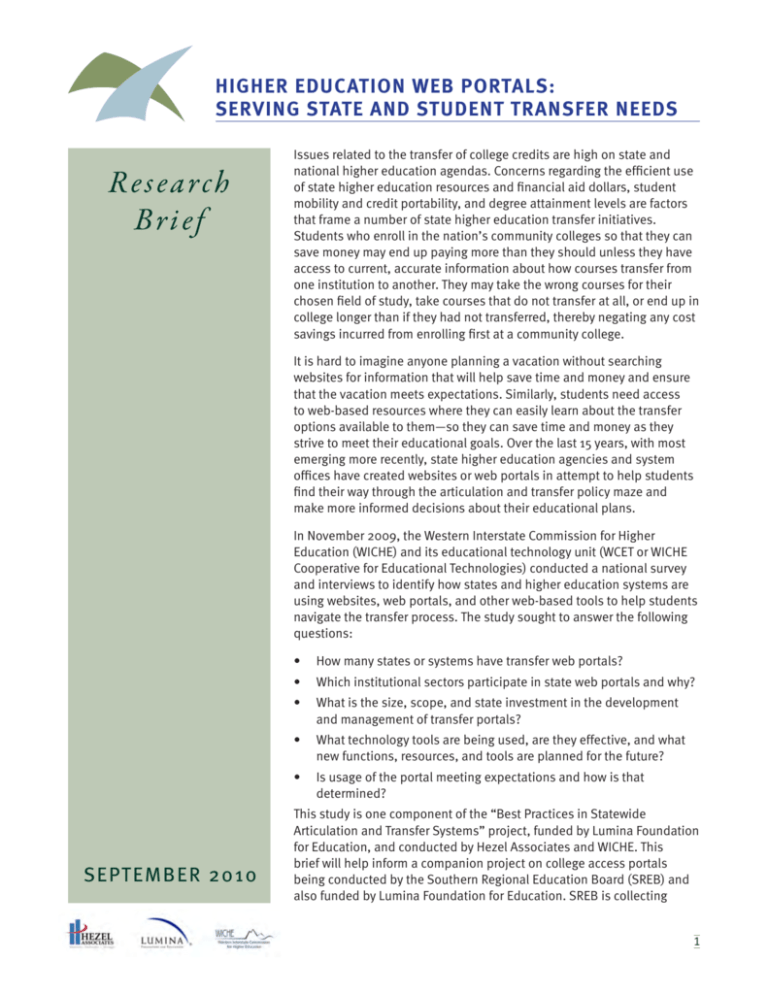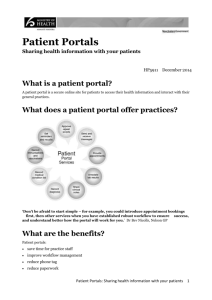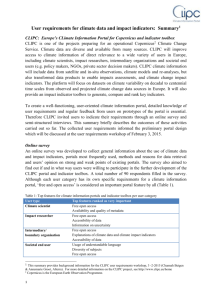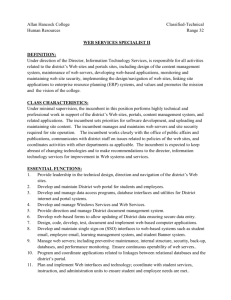Higher Education Web Portals: Serving State and Student Transfer
advertisement

HIGHER EDUCATION WEB PORTALS: SERVING STATE AND STUDENT TRANSFER NEEDS Research Brie f Issues related to the transfer of college credits are high on state and national higher education agendas. Concerns regarding the efficient use of state higher education resources and financial aid dollars, student mobility and credit portability, and degree attainment levels are factors that frame a number of state higher education transfer initiatives. Students who enroll in the nation’s community colleges so that they can save money may end up paying more than they should unless they have access to current, accurate information about how courses transfer from one institution to another. They may take the wrong courses for their chosen field of study, take courses that do not transfer at all, or end up in college longer than if they had not transferred, thereby negating any cost savings incurred from enrolling first at a community college. It is hard to imagine anyone planning a vacation without searching websites for information that will help save time and money and ensure that the vacation meets expectations. Similarly, students need access to web-based resources where they can easily learn about the transfer options available to them—so they can save time and money as they strive to meet their educational goals. Over the last 15 years, with most emerging more recently, state higher education agencies and system offices have created websites or web portals in attempt to help students find their way through the articulation and transfer policy maze and make more informed decisions about their educational plans. In November 2009, the Western Interstate Commission for Higher Education (WICHE) and its educational technology unit (WCET or WICHE Cooperative for Educational Technologies) conducted a national survey and interviews to identify how states and higher education systems are using websites, web portals, and other web-based tools to help students navigate the transfer process. The study sought to answer the following questions: • How many states or systems have transfer web portals? • Which institutional sectors participate in state web portals and why? • What is the size, scope, and state investment in the development and management of transfer portals? • What technology tools are being used, are they effective, and what new functions, resources, and tools are planned for the future? • Is usage of the portal meeting expectations and how is that determined? SEPTEMBER 2010 This study is one component of the “Best Practices in Statewide Articulation and Transfer Systems” project, funded by Lumina Foundation for Education, and conducted by Hezel Associates and WICHE. This brief will help inform a companion project on college access portals being conducted by the Southern Regional Education Board (SREB) and also funded by Lumina Foundation for Education. SREB is collecting 1 Higher Education Web Portals: Serving State and Student Transfer Needs information about college access web portals to define, document, and categorize features; evaluate effectiveness; and offer recommendations for the future development and support of state, regional, and selected national college access web portals. The findings of their research will be published in late 2010. Together, the findings from both the WICHE and SREB research will help lay the groundwork for important discussions about the policy landscape around web portals, including their effectiveness and what the future may hold. What is a Portal? “A door or gate; hence, a way of entrance or exit, especially one that is grand or imposing.” Webster’s Online Dictionary “… presents information from diverse sources in a unified way … Portals provide a way for enterprises to provide a consistent look and feel with access control and procedures for multiple applications and databases, which otherwise would have been different entities altogether. Wikipedia entry on “web portals” 05/05/10 “… key points would appear to be the portal’s ability to offer customisation, personalisation and integration of content and services drawn from a range of sources.” “Towards a Typology for Portals” by Paul Miller1 WHY CREAT E T R A N S F E R P O RTA L S ? Almost 60 percent of first-time bachelor’s degree recipients attend more than one institution.2 These “swirling” students often encounter setbacks resulting from lost credit and increased financial debt. As states focus on increasing degree completion rates to meet national goals and economic demands, state policymakers must pay greater attention to transfer policies and related services available to these students. The benefits of a single, centralized and trusted source of information, services, and resources about transfer extend across the board to students, institutions, and states alike but not with equal value. States and institutions realize the potential benefits at the very start of a portal project by the increased communication and collaboration among institutional partners. For students, however, the 2 value of convenient access to transfer information via a portal—and how that access impacts their successful transfer experience—is less certain. This research brief describes how web portals can, or should, serve transfer students and support state higher education goals. State Perspectives The portal can be viewed as an extension of a state’s efforts to develop clear, consistent articulation and transfer policies and procedures. It places institutional agreements, student transfer guides, course equivalency information, and institutional participation (or non-participation) in transfer processes in the public eye. Portals provide structure and a set of requirements that can assist states in consolidating information from multiple institutions. The portal is less about the policies themselves and more about serving students—in a sense, putting the policies into practice. Many portals are the outgrowth of prior work by student services personnel, such as registrars and transfer coordinators, and faculty articulation committees. In these instances, the portal is an extension of years of interinstitutional collaboration. The portal promotes a current, upto-date presentation of transfer information and can incentivize institutional engagement. The portal becomes a way for states to demonstrate greater levels of coordination, accountability, and transparency. “When the website and the information is maintained, current, and well presented, it becomes an opportunity to showcase higher education…making good use of public resources and evidence of collaboration among colleges and universities.” – Gary Langer, Academic Vice Chancellor, Minnesota State Colleges and Universities Institutional Perspectives Institutional leaders may have varying perceptions of the costs and benefits of campus participation in a portal development and maintenance effort, depending upon the existing climate of institutional cooperation, goals of the portal project, history Higher Education Web Portals: Serving State and Student Transfer Needs behind the effort, and requirements of staff and faculty time. Institutional participation in the state or system portal project can call attention to whether or not interinstitutional articulation and transfer agreements are in place and adhered to by the institutions. The robust and increasingly easy-to-use commercial products, as well as locallydeveloped solutions, allow for easier and more efficient processes benefitting faculty and staff. More importantly, these tools make it easier to keep course equivalency information and transfer agreements current. As institutions face evergrowing numbers of transfer applications, these more streamlined business functions become more manageable. “The process of establishing the [transfer] agreements and keeping them current requires considerable commitment because institutions frequently revise their courses and degree requirements …While transfer agreements can be time-consuming, they help make the transfer process more transparent.”3 students frequently opt-out of transfer because of the difficulty in following the various transfer guides produced by the different higher education systems.4 Despite the complexity and volume of the information presented, a well-organized portal represents a self-service model that addresses the needs of today’s students who want the ability to get the information and services they need when they need them. If the portal does not include the information that they need, students may look beyond their public education system to other educational providers whose marketing and student services may seem more welcoming. The ability to tailor and personalize “channels” of information to best suit the users suggest that institutions and states can present information and services that are transfer-student centric. For example, MN Transfer in Minnesota provides separate sections (entry ways) for two-year transfer students, military veterans, and online students, thus presenting subgroups of students with relevant information targeted to their unique needs. To summarize, transfer portals are intended to: A Student Perspective The potential advantages that portals can offer to students may be obvious—easier access to transfer information that has been stripped of “policy-speak” and clearly explains their options. An August 2009 report on transfer in California, however, noted that • Serve as a single point of entry to obtain user-friendly, comprehensive, and up-to-date information on transfer. • Give students immediate access to the tools and resources that can help them understand their transfer options. Figure 1. Transfer Portals Reported in Survey AL Statewide Transfer & Articulation Reporting Systems (STARS) IN TransferIN.net OR Oregon University System KY GoHigherKentucky AZ Arizona Transfer MA MassTransfer PA Pennsylvania Transfer and Articulation Center (PA TRAC) AR Arkansas Course Transfer System MI Michigan Transfer Network CA Articulation System Simulating Interinstitutional Student Transfer (ASSIST) MN Minnesota Transfer FL Florida’s Advising, Counseling and Tracking for Students (FACTS) NH NH Transfer HI UH System Course Transfer Database IL iTransfer MT Montana University System NC College Foundation of North Carolina (CFNC.org) SC South Carolina Transfer and Articulation Center (SC TRAC) TX Transfer 101 (University of Texas System) VA State Council of Higher Education for Virginia Transfer Tool OH Credit Transfer VA Virginia Education Wizard (VA Community College System) OK Oklahoma State Regents for Higher Education WI UW Transfer Information System (University of Wisconsin System) 3 Higher Education Web Portals: Serving State and Student Transfer Needs Twenty-four surveys were completed producing a response rate of 65 percent. Figure 1 lists the transfer portals included in this report. • Reduce the workload on faculty and advisors to maintain information on course equivalencies, degree requirements, and transfer agreements. • Highlight services and communications that are transfer-student centric and welcoming to transfer students. Additionally, interviews were conducted with a small sample of higher education administrators of portals as well as private sector executives whose companies offer products and services for higher education portals. • Promote cooperation and collaboration among public and private institutional partners. Key Findings METHODS U SE D I N T H I S ST U DY State or higher education system-wide transfer portals are not a new innovation. Some have been in place for more than 15 years, although the older ones may not have referred to their sites as “portals.” South Carolina’s Transfer and Articulation Center is the newest higher education web portal, launched in April 2010 (the culmination of four years of effort). The most significant growth has been in the past five years, with one-half of the sites in the survey launched since 2005. The link to the online survey, “Facilitating Transfer Decisions Through the Use of Web-Based Tools,” was emailed to 37 transfer sites administered by states, consortia, and college or university systems in the U.S. in November 2009. The 37 targeted sites were selected from an initial list of 118 educationrelated websites compiled from several sources, including initial research by SREB for its companion portal study of college access sites as well as additional internet research. Two requirements were established to participate in the survey: Representation and Roles of Institutional Sectors • The site must include credit transfer information specific to at least three or more public institutions located in the state. Institutional Sectors Represented. The majority of the sites aim to be comprehensive, statewide portals for the public postsecondary system. Figure 2 displays the types of institutional sectors that are currently represented in the web portals • The site must include information, services, or tools that provide the user with more than simple links/pointers to legislation, agreements, or institutional websites. Figure 2. Higher Education Sectors Currently Represented in the Web Portal Public Institution Participation * * * * * Publics required to participate Publics not required to participate Other transfer sites exist Out-of-state public institutions * * * Note: State and higher education systems that responded to the survey are shaded. In Virginia, two transfer sites are represented: SCHEV’s Transfer Tool (public institutional participation required) and the Virginia Education Wizard run by the Virginia Community College System (participation not required). 4 Non-public Institution Participation * * * In-state private institutions Out-of-state private institutions For-profit institutions Note: Transfer information for other than in-state public institutions may be provided through commercially-licensed services. Higher Education Web Portals: Serving State and Student Transfer Needs (public, private, for-profit) as well as sites that provide transfer-related information for out-of-state institutions. If a goal is to make it easier for students to locate and use relevant information, some level of coordination ought to be pursued within a state when similar or competing sites for transfer resources exist. For example, 16 sites reported that public institutions are required to participate, and seven of these also indicated that other transfer websites exist in their state. Further, several reported that some level of collaboration exists among the multiple sites. A comparison of the two maps also demonstrates that a number of states have reached out to their in-state private institutions, thus providing students with a more complete picture of transfer options in their state. In North Carolina, for example, the private, independent institutions have had a seat at the table from the outset of the planning for the College Foundation of North Carolina initiative (CFNC.org). Minnesota’s transfer portal provides an example of a more regional and student-centric view, by including select institutions from neighboring states where extensive transfer occurs. In many cases, transfer information for other than in-state public institutions is provided through the site’s license with a commercial database of course credit/equivalency information for participating institutions nationally. An example is u.select, a commercial database of course equivalency information linked from a state portal. Roles of Institutions. Institutional buy-in is critical throughout the life cycle of these sites. Respondents cited various committee structures and institutional reporting models. Regardless of the model, it is important to acknowledge the integral role of institutional administrators, faculty, and advisors in ensuring accurate and complete information about equivalencies, and program or degree requirements. The institutional roles were described most often as either an active contributor, such as an appointed transfer advisory committee Massachusetts’ institutions have played a continuum of roles in different stages, including serving as full partners when the original Task Force was created to implement the state’s MassTransfer policies and website. making recommendations on course equivalencies, or a content provider only, such as institutional responsibilities for annual reviews and updates. Funding Sources and Operations The funding sources for initial web portal development vary as shown in Figure 3, with state appropriations as a source for half of the respondents. As shown in Figure 4, the reported FY 2010 budgets for the operation of these 24 sites range from less than $200,000 to more than $1 Figure 3. Funding Sources for Portal Development State appropriations (12 respondents) Reallocation of existing funds (5 respondents) Other (3 respondents) Grant funds (4 respondents) Fees charged to institutions (3 respondents) Figure 4. FY 2010 Operating Budget $100,000 - $350,000 (6 respondents) Less than $20,000 (2 respondents) Over $1 million (1 respondent) $600,000 - $1 million (5 respondents) 5 Higher Education Web Portals: Serving State and Student Transfer Needs million. Several survey respondents did not provide budget information, including some whose portals include integrated systems and advanced features from commercial providers. In some instances, the website or portal development is only one component of a larger statewide higher education access and achievement initiative, so the reported FY 2010 budget may cover more than website administration and operations. The primary budget expenditure across the board is for staffing, except for portals that have contracted with a third-party provider to oversee administration and operations of their sites. Most sites have no designated funds allocated to marketing; exceptions are Illinois and Pennsylvania. Commercial or Home-grown Solutions Ten of the 24 survey respondents indicated they purchase or license commercial products to facilitate some aspect of the credit evaluation and transfer services available on the website. Twelve reported the use of a custom-built program or database to provide students with information about their credit equivalencies or program requirements. North Carolina, Pennsylvania, and South Carolina are among the newer sites that are utilizing the full suite of services offered by commercial providers. Several sites with home-grown solutions have been in existence for more than 10 years. Based upon the reported levels of satisfaction with site usage, no difference in satisfaction is noted between the use of commercial versus locally-built solutions. Functions, Resources, and Tools Portals ideally serve as a centralized site from which students can access all information that can help them facilitate academic transfer. First and foremost, the portal must provide accurate information about the state’s transfer and articulation policies, written in an easily digestible format. A combination of webbased tools, built locally or purchased commercially, should be available to students to understand how state policy applies to their own educational plans. In some cases, students have access to transfer guides that clearly lay out course requirements needed to transfer to a partner institution with minimal loss of credit. In some portals, students obtain a more personalized assessment of how their credits may transfer. Portals should also 6 provide other tools, services, and resources that facilitate the actual transfer process, such as online applications or online access to advising. Yet, data show that web portals with transfer functions vary in terms of the resources and tools that they provide. The survey offered a comprehensive list of functions, resources, and tools—some static and some interactive—that could be used by students to make more informed educational plans. Table 1 summarizes the functions, resources, and tools that are currently “available,” “planned,” or “not planned” for the future. For any given tool or functionality already available on the site, respondents reported on their perceived effectiveness in helping students with transfer decisions (“effective,” “somewhat effective,” “not effective,” or “don’t know”). With a single exception, respondents rated those available on their sites as either effective or somewhat effective. Personal Accounts for Users. Portals, by definition, allow for personalization and customization, beginning with the user creating a personal account and login password. The survey asked whether user accounts for students, faculty/advisers, or parents are currently available or planned in the future. Surprisingly, more sites indicated that login accounts for faculty and advisers are or will be available than for students, with 12 of these indicating no plans for student accounts. This suggests the portal is an important tool for institutions to maintain and verify the accuracy of course and program transfer information, but is not necessarily a student portal. Absent an account feature, students have no mechanism for saving and reviewing information about their transfer options and transfer history. This capability adds to the financial and technical requirements and is found in several sites that were developed within the last five years. Customizable Views of Course and Program Information. Eighteen sites indicated that students have, or will have, the ability to perform customizable course-to-course equivalency comparisons as well as access to customizable views of credit transfer information for specific majors and degree programs. Whether the course or credit equivalency information is presented in an interactive or static form, most sites include Higher Education Web Portals: Serving State and Student Transfer Needs Table 1. Functions, Resources, and Tools by Number of Sites User Accounts Available Planned Not Planned Personal Login Accounts for students 10 2 12 Personal Login Accounts for faculty/advisors 11 3 10 Personal Login Accounts for parents 4 2 17 Sign up for email announcements and messages 5 6 12 Sign up for Web 2.0 messages 3 5 14 Creates personal portfolio (customizable) 6 3 14 Transfer Resources and Tools Static tables/matrices of course-to-course equivalency comparisons 14 3 6 Customizable, dynamic, or interactive course-to-course equivalency comparisons 17 1 6 Static tables of credit transfer information for specific majors and degree programs 10 5 9 Customizable, dynamic, or interactive credit transfer information for specific majors and degree programs 12 6 6 General Education requirements and transfer eligibility 20 1 3 Degree program requirements/graduation requirements 14 4 6 Links to articulation agreements 15 3 4 Comparative review of multiple in-state institutions based on specific criteria 6 2 16 Links to in-state colleges and universities 17 2 4 Links to out-of-state colleges and universities 2 1 18 Method to ask questions and receive personal responses 16 1 4 Other Components and Tools Online admissions application 8 3 12 Downloadable admissions application 8 2 13 Financial aid information 13 1 9 Financial aid forms 8 2 13 Request transcripts 5 3 15 Career planning tools 8 5 10 Prior Learning Assessment tools 2 4 16 Online course catalog 10 3 10 Spanish language option 4 3 16 Find an advisor service 9 2 11 File a transfer grievance form 7 2 13 7 Higher Education Web Portals: Serving State and Student Transfer Needs provisos to inform students that determination of actual transfer of course credits are the purview of the admitting institution. With the addition of links to general education requirements, articulation agreements, online course catalogs, and other resources, the majority of these sites do serve as a comprehensive, single site for policies, agreements, and resources on transfer. For example, Indiana’s Core Transfer Library (CTL) allows students to search by institution or course subject area courses that meet general education or free elective requirements of undergraduate programs at state public institutions. Expansion to include the state’s private, independent institutions is underway. Transcripts and Applications. Student access to tools that could streamline the transfer process, such as the ability to request a transcript or apply online, is available currently or planned as a future enhancement for only about one-third of the sites (see Table 2). Sites that are maintained by a university partner tend to offer these services as part of their standard services for prospective students. Social Media. The majority of survey respondents indicated that these sites are not taking advantage of social networking technologies to reach students. Fourteen sites indicated that the addition of a Facebook fan page, link to a Twitter feed, or an option to sign up for email announcements are not planned for future iterations of the site. Some sites that are hosted by a college or university are taking the same communications tools used on campus and incorporating them in the transfer website, Summary of Commercial Providers and Products Course Equivalency/Comparison and other Transfer Products: Several state web portals utilize hosted services and licenses to national course equivalency databases to offer comprehensive and easy-to-use tools to create, publish, and maintain course and program information. The major corporations and some of their related products are listed here. Company: Academy One, Inc. Example of products: CollegeTransfer.Net, National Course Atlas, Student Passport Used in these state portals (from among survey responses): Arkansas, Pennsylvania, South Carolina Company: Decision Academic Example of products: Curriculum Navigator, Program Navigator, Catalog Navigator, Transfer Navigator Used in these state portals (from among survey responses): North Carolina Company: College Source/redLantern Example of products: College Source Online, Transfer Evaluation System (TES), u.select Used in these state portals (from among survey responses): Arizona, Illinois, Indiana, Kentucky, Minnesota, Ohio, Oregon Electronic Transcript Initiatives: Electronic transcript exchange services can save students and institutions time and money. Some of the major electronic transcript providers are listed here. ConnectEDU offers e-transcription solutions to bridge the transition from high school to college and, in 2010, announced a partnership with the National College Access Network. eTranscript California provides an electronic transcript exchange service to all of California’s postsecondary institutions, both public and private. Docufide‘s electronic transcript exchange system is deployed in ten states on a statewide basis. National Student Clearinghouse maintains a comprehensive electronic registry of student records for organizations and individuals requiring verification of student enrollment, degree, and loan data as well as a transcript exchange service for K-12 and higher education. XAP Corporation’s services for higher education include electronic college applications, e-transcript exchange, and mentor services that provide students with information and resources about going to college. 8 Higher Education Web Portals: Serving State and Student Transfer Needs Table 2. Transcripts and Application Tools Request transcript Download application Apply online Both downloadable and online application Tool Exists Tool Tool Not Planned Planned 5 1 1 2 0 1 16 1 0 7 2 12 such as signing up for email updates and Twitter. Indiana, Kentucky, Massachusetts, New Hampshire, and North Carolina will be adding social networking services to extend their communications with students. Other Tools and Future Enhancements. Ongoing enhancements and improvements are planned for nearly all of the sites. More than half reported plans to provide more information or tools to help students assess how their credits would transfer, interpret that information, and take immediate action, such as applying to an institution or completing necessary forms. Several reported that they had plans to add or improve the functionality of services used by faculty and advisers in the updating and maintenance of curricular modules. Better data collection and metrics regarding usage of the site and its resources were reported as high priorities for several sites, including Montana, North Carolina, and South Carolina. Examples of other interesting features as well as future enhancements include: • Pennsylvania will add information about alternative methods of earning credits, e.g. prior learning assessment, dual enrollment, and credit by exam. • The University of Texas System plans to add a new Spanish language section. • Arizona launched a new service, called Transfer Student Ombudsperson Chatlines (TSO Chatlines), with designated staff on each campus assigned to respond to transfer students’ email queries. • The Illinois iTransfer.org site includes a link to “The Articulation Advocate,” an online newsletter for transfer coordinators of Illinois colleges and universities. • South Carolina’s SC TRAC site includes a Transfer and Articulation Reading Room with links to research and news articles about transfer and articulation as one strategy to raise general awareness in the state. Measuring Impact While portals can offer many advantages to states and institutions from both a public policy perspective and a business efficiency perspective, benefits to students are more difficult to assess. The survey asked portal administrators to indicate if they were satisfied with the level of usage of the site and to identify the measures they use to assess the site’s impact. With just three exceptions, those responsible for the portal administration are quite satisfied with the amount of usage the site is receiving. Most are monitoring usage according to standard metrics such as total visits, number of unique visitors, time spent on pages, etc. However, these usage data do not answer questions about who is using the site, how they are using it, and if the site is helpful. In response to the question, “What site usage measurements are most useful to your organization for understanding its [the portal] impact?” only about one-half could report the capability of monitoring account activity per unique, personal accounts created by either students, faculty, or both. Other activities that are monitored to assess usage include the number of email inquiries, reports generated, equivalencies viewed, searches by institution, and use of specific tools available on the site. Alabama’s Statewide Transfer & Articulation Reporting System (STARS), for example, allows two-year students to create a customized guide to plan coursework that will be accepted for transfer to an in-state, public four-year institution. The STARS For North Carolina’s initiative (CFNC.org), the development of a more robust research and evaluation plan is a high priority for future efforts. CFNC.org added a disclaimer to the site’s privacy policy that it will be tracking college enrollment and retention data on individual account holders through the National Student Clearinghouse (NSC). According to its 2009 annual report, CFNC.org will pursue a statewide NSC license with expectations to begin a pilot test of college enrollment and retention.5 9 Higher Education Web Portals: Serving State and Student Transfer Needs site prominently displays a link to detailed usage reports, including the number of students who create personalized guides for their educational planning. The true impact of these portals on student success, however, is largely unknown. STRATEGIES F O R S U CCESS F U L PORTALS A state considering establishing a web portal as one strategy to promote a more efficient higher education system can learn from the experiences of others. Regardless of the amount of funding reported by the survey respondents to launch their sites, the long-term commitment to the maintenance and support of these sites is evident. Several administrators reported that their portals have undergone up to three to five revisions since initially being created. Since the portals represent a significant investment of resources on the part of the state and institutions, it is important to consider the following strategies as having a positive impact on the development and ongoing use of portals. Recruit State and Institutional Champions. Strong leadership is emphasized as a key success factor. Leadership was cited as especially important in the larger, more sophisticated, higher-cost portal development projects. At the foundation of a portal initiative, higher education policymakers and institutional leaders must be committed to articulation and credit transfer policies that help students stay on track towards degree completion. Even with the groundwork of the underlying institutional agreements in place, these large-scale portal initiatives require significant institutional investments of staff and faculty time. In addition, a decision-making body, with some level of authority, must be in place to respond quickly to issues. Engage Stakeholders Early in the Development Process. Buy-in from all stakeholders, including faculty, is essential and especially important among all the participating institutions. The institutions must accept a long-term commitment to the portal project as their role is essential in maintaining the accuracy of the course and program content. Importantly, institutional participation in the portal development may have a positive influence on more transfer student-centric services, resources, and messages. 10 Understand the Metrics for Reporting. Site usage data are a primary measure of success for several sites. Depending on the site’s specific goals, it is important to have identified during the early planning stage the data and other metrics that will be collected, evaluated, and reported to stakeholders. If a third-party service is employed to host the site, higher education agencies need to clarify issues of data ownership and the ability to produce customized reports. Another measure of success may be growth in the number of course equivalencies housed within the portal. It also is important to clarify expectations about whether student-specific data will be available. Build on Established Transfer Policies and Agreements. If the transfer policies and practices are uncoordinated, not practiced, or nonexistent, a portal initiative should not be the driver. For example, the MassTransfer portal in Massachusetts was developed only after a period of months following the approval of the MassTransfer policy by a task force which included campus representatives. Take Advantage of a Pre-Existing Culture Of Collaboration. Gaining institutional support and participation may be facilitated in instances where institutions have collaborated in other system-wide or statewide initiatives, such as implementation of a common student information system or participation in statewide professional organizations of registrars or transfer coordinators. The transfer sites in Indiana, Minnesota, and Oregon serve as examples of successfully leveraging an established crosssector culture of trust and cooperation. Regularly Communicate with Stakeholders. In many instances, the portal is one of several discrete strategies or components of a state’s action plan to improve postsecondary student success and completion. Oftentimes the state action plan process, with the portal being one of the outcomes, can take several years to launch. Therefore, regular communication, such as progress on specific milestones, is essential to provide to all stakeholders. Invest in Marketing. Few sites report a marketing budget for the portal. Most rely on low-cost marketing approaches such as encouraging counselors and advisors to tell students and encouraging participating institutions to post links and distribute brochures about the portal. Only one- Higher Education Web Portals: Serving State and Student Transfer Needs quarter of the respondents report the use of media advertisements. An exception is Pennsylvania. The Pennsylvania Department of Education’s promotional toolkit, “Take Your Credits with You,” makes it easy for colleges to reproduce materials. The toolkit presents a consistent, complete message about the state’s transfer credit framework as well as instructions to students on how to use the website. Audit Your Web Presence. Ensure that the institutional partners promote the transfer portal to prospective students. States should evaluate how easy or difficult it is for students to find a link to the transfer portal or information about the state’s transfer initiative from the website of their home institution and whether the transfer portal information is timely, accurate, and consistent. Tell Your Story. Just one-half of the survey respondents indicate that progress reports with information on usage and future plans are produced, and of these, only two are a mandatory requirement. More self-promotion and awareness building among state policy and education leaders would serve the interests of all parties who make the transfer site and its underlying processes work. WHAT’S TO CO M E ? Web portals can assist students with transfer decisions and build institutions’ capacity for improving transfer processes. A highly visible, centralized web presence about a state’s transfer and articulation policies can positively influence states, institutions, and students by affording convenient and up-to-date access to key information. While more research is needed to answer the question of the actual impact on student transfer decisions, the following indicators from this survey are encouraging. • High level of satisfaction with usage of the sites. • Planning underway for expansion, upgrades, and enhancements. • Stronger collaborations among public and private institutions and other educational entities. • Increased awareness of the need for transferfriendly student services on campuses. Looking ahead to the next three to five years, one would expect to see more states with centralized, coordinated higher education web portals as one strategy to improve transfer rates. Other trends that may emerge as the newer portals mature relate to research, technology, statewide goals, and commercial and open source solutions. More Research and Evaluation. Several of the wellfunded, comprehensive, statewide portal initiatives have established a high priority for better data collection and research on the use and impact of the site. The research agenda should address the impact of the portal on student transfer patterns as well as its influence on institutional practices concerning transfer students. New Technologies and Applications. Technologies that support access to information and communications among students and institutions will change. The current explosion in the development and use of mobile applications is just one example of how these sites will need to adopt new technologies in the future. Consistency with Statewide Goals. Higher education web portals will be one component of a state’s overall strategic plan for economic and workforce development, and as such, other state agencies will have a stake in the planning and operation of these sites. As states are working to create effective educational pathways in K-20 and beyond, portals can address the needs of all students. State-level leadership and coordination is required to ensure that all higher education portals—ones addressing high school, transfer, and adult students—are fully integrated or at least easily connected to broader statewide portals. More Refinement of Solutions. States that have developed web portals more recently tend to have adopted a commercial solution. This suggests a trend toward this option in the future. The vendor community has a strong presence in discussions about student information systems, course comparison tools, e-transcripts, and other systems designed to create more efficient and effective business practices involved in the transfer process. Already a competitive market for vendors, it will continue to be so. The experiences from their other higher education clients can be valuable, but it is important to recognize that they operate as a private business. Higher education institutions increasingly are adopting open source solutions for e-learning 11 Higher Education Web Portals: Serving State and Student Transfer Needs and a broad array of other technology applications. Thus, open source also may emerge as an additional option for some components of state and system transfer portals. Regardless of the solution, states need to ensure that they are clear about data ownership and reporting, evaluation, and exit strategies as the environment rapidly evolves. Web portals are just one strategy that states are employing to ease transfer for their students. While there is considerable investment in these tools and widespread satisfaction among those administering the sites, the true impact is largely unknown. As states look to the future of web portals, they need to find better ways to measure their utility for states and institutions, and most importantly, their impact on students’ transfer decisions and ultimate academic success. For more information about the Best Practices in Statewide Articulation and Transfer Systems project, including links to related publications: www.wiche.edu/stas Additional Resources: Lumina Foundation for Education www.luminafoundation.org Southern Regional Education Board www.sreb.org Western Interstate Commission for Higher Education www.wiche.edu WICHE Cooperative for Educational Technologies http://wcet.wiche.edu/ E N D N OT ES 1 Paul Miller, “Towards a Typology of Portals,” Ariadne, 37 (Oct-Dec 2003) accessed on 30 March 2010 at <http://www. ariadne.ac.uk/issue37/miller/>. 2 Katharin Peter and Emily Forrest Cataldi, The Road Less Traveled? Students Who Enroll in Multiple Institutions, NCES 2005-157 (Washington, D.C.: U.S. Government Printing Office, U.S. Department of Education, National Center for Education Statistics, 2005), 33. 3 United States Government Accountability Office, Transfer Students. Postsecondary Institutions Could Promote More Consistent Consideration of Coursework by Not Basing Determinations on Accreditation, (Washington, DC: United States Government Accountability Office, 2005) GAO-06-22, 11. 4 Colleen Moore, Nancy Shulock, and Cristy Jensen, Crafting A Student-Centered Transfer Process in California: Lessons from Other States (Sacramento: Institute for Higher Education Leadership and Policy, California State University Sacramento, 2009), 1. 5 University of North Carolina General Administration, An Evaluation of North Carolina’s College Planning Web Portal (Chapel Hill, NC: University of North Carolina, 2009). A B O U T T H E AU T H O R Mollie McGill is the deputy director for programs and membership for the WICHE Cooperative for Educational Technologies (WCET)—a national membership-based organization that works to accelerate the adoption of effective practices and policies, and advance excellence in technologyenhanced teaching and learning in higher education. She oversees membership services and a variety of programs that aim to inform the e-learning community of promising practices and effective policies on such topics as academic integrity, student authentication, and student retention in online learning. McGill received her education degree from Emporia State University. The views expressed in this report are those of the author and do not necessarily represent those of Lumina Foundation for Education, its officers, or employees. Copyright © September 2010 by the Western Interstate Commission for Higher Education 3035 Center Green Drive, Suite 200, Boulder, Colorado 80301-2204 • 303.541.0200 An Affirmative Action/Equal Opportunity Employer • Printed in the United States of America • Publication Number 2A375 12








